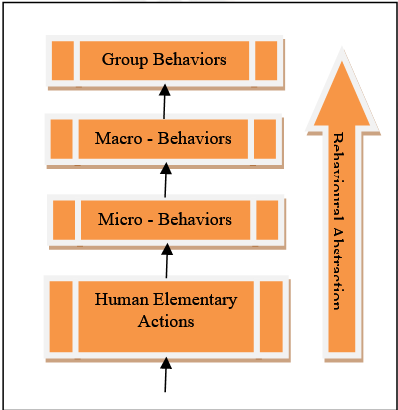Human Behaviour Recognition using Fuzzy System in Videos
Main Article Content
Abstract
Human behavior can be detected and analyzed using video sequence is a latest research topic in computer vision & machine learning. Human behavior is used as a basis for many modern applications, such as video surveillance, content-based information retrieval from videos etc. HBA (Human behaviour analysis) is tricky to design and develop due to uncertainty and ambiguity involved in people’s daily activities. To address this gap, we propose hierarchical structure combining TDNN, tracking algorithms, and fuzzy systems. As a result, HBA system performance will be improved in terms of robustness, effectiveness and scalability.
Article Details
References
W.Hu, T. Tan, L Wang, S. Maybank, A survey on visual surveillance of object motion and behaviors, IEEE Trans. Syst. Man Cybernet. 34 (2004) 334-352.
R. Hui, Video Content Analysis of Human Sports under Engineering Management Incorporating High-Level Semantic Recognition Models, Computational Intelligence and Neuroscience, Volume 2022, Article ID 6761857, 12 pages.
F. Sulser, I. Giangreco, H. Schuldt, Crowd-based Semantic Event Detection and Video Annotation for Sports Videos, International ACM Workshop on Crowd sourcing for Multimedia, Nov. 2014, Pages 63-68.
P. Borges, N. Conci, A. Cavallaro, Video-based human behavior understanding: a survey, IEEE Trans. Circ. Syst. Video Technol. 23 (11) (2013) 1993–2008.
O. Brdiczka, J. Crowley, P. Reignier, Learning situation models in a smart home, IEEE Trans. Syst. Man Cybernet. Part B: Cybernet. 39 (1) (2009) 56–63.
P. Dai, H. Di, L. Dong, L. Tao, G. Xu, Group interaction analysis in dynamic context, IEEE Trans. Syst. Man Cybernet. Part B: Cybernet. 39 (1) (2009) 34–42.
K. Huang, D. Tao, Y. Yuan, X. Li, T. Tan, View-independent behavior analysis, IEEE Trans. Syst. Man Cybernet. Part B: Cybernet. 39 (4) (2009) 1028–1035.
C.H. Lim, E. Vats, C.S. Chan, Fuzzy human motion analysis: a review, Pattern Recogn. 48 (5) (2015) 1773–1796.
A. Oikonomopoulos, I. Patras, M. Pantic, Spatiotemporal salient points for visual recognition of human actions, IEEE Trans. Syst. Man Cybernet. – Part B 36 (3) (2006) 710–719.
O. Popoola, K. Wang, Video-based abnormal human behavior recognition: a review, IEEE Trans. Syst. Man Cybernet. Part C: Appl. Rev. 42 (6) (2012) 865–878.
S. Calderara, U. Heinemann, A Prati, R. Cucchiara, N. Tishby, Detecting anomalies in people’s trajectories using spectral graph analysis, Computer Vision and Image Understanding 115 (2011) 1099-1111.
Wang, H.; Schmid, C. Action recognition with improved trajectories. In Proceedings of the IEEE International Conference on Computer Vision, Kyoto, Japan, 21–23 May 2013; pp. 3551–3558.
R. Di Lascio, P. Foggia, A. Saggese, M. Vento, Tracking interacting objects in complex situations by using contextual reasoning, in: 2012 International
Conference on Computer Vision Theory and Applications (VISAPP), 2012.
R. Di Lascio, P. Foggia, G. Percannella, A. Saggese, M. Vento, A real time algorithm for people tracking using contextual reasoning, Comput. Vis. Image Underst. (2013).
D. Karras, On improved MRI segmentation using hierarchical computational intelligence techniques and textural analysis of the discrete wavelet
transform domain, in: IEEE International Symposium on Intelligent Signal Processing, 2007, WISP 2007, 2007, pp. 1–6.
A.T. Lawniczak, B.N.D. Stefano, Computational intelligence based architecture for cognitive agents, Proc. Comput. Sci. 1 (1) (2010) 2227–2235.
Y. Lin, Affective driving, in: S. Fukuda (Ed.), Emotional Engineering, Springer, London, 2011, pp. 263–274.
J. Albusac, D. Vallejo, J. Castro-Schez, L. Jimenez-Linares, Oculus surveillance system: fuzzy on-line speed analysis from 2D images, Expert Syst. Appl. 38 (10) (2011) 12791–12806.
C.C. Loy, T. Xiang, S. Gong, Detecting and discriminating behavioural anomalies, Pattern Recogn. 44 (1) (2011) 117–132.
J. Azorin-Lopez, M. Saval-Calvo, A. Fuster-Guillo, J. Garcia-Rodriguez, Human behaviour recognition based on trajectory analysis using neural networks, in: International Joint Conference on Neural Networks (IJCNN), 2013, pp. 1–7.
R. Laxhammar, G. Falkman, Online learning and sequential anomaly detection in trajectories, IEEE Trans. Pattern Anal. Mach. Intell. 36 (6) (2014) 1158–1173.
N.T. Siebel, S.J. Maybank, The advisor visual surveillance system, in: ECCV 2004 Workshop Applications of Computer Vision (ACV), 2004.
D. Duque, H. Santos, P. Cortez, Prediction of abnormal behaviors for intelligent video surveillance systems, in: IEEE Symposium on Computational Intelligence and Data Mining, 2007, CIDM 2007, 2007, pp. 362–367.
B. Degardin, H. Proenca, Human Behavior Analysis: A Survey on Action Recognition. Appl. Sci. 2021, 11, 8324.
L. Ballan, M. Bertini, A. D. Bimbo, Event detection and recognition for semantic annotation of video, Multimed Tools Appl (2011) 51:279-302.
M. Vrigkas, C. Nikou, L. A. Kakadiaris, A review of human activity recognition methods, Front. Robot. AI, 16 November 2015.
Kong, Y., Fu, Y. Human Action Recognition and Prediction: A Survey. Int J Comput Vis 130, 1366–1401(2022). https://doi.org/10.1007/s11263-022-01594-9

